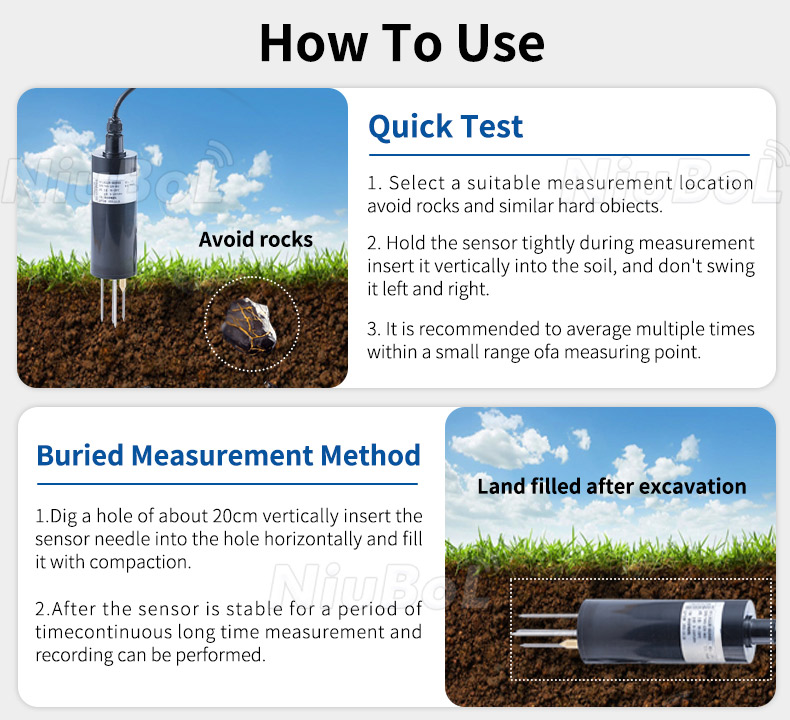

— Blogs —
—Products—
 Consumer hotline +8618073152920
Consumer hotline +8618073152920 WhatsApp:+8615367865107
Address:Room 102, District D, Houhu Industrial Park, Yuelu District, Changsha City, Hunan Province, China
Product knowledge
Time:2024-04-12 13:51:39 Popularity:560
The linkage of soil temperature and humidity sensors to an irrigation system is usually accomplished through a centralized control system that automatically monitors soil temperature and humidity data and regulates the opening and closing of irrigation valves based on this data. The following are the general steps to realize this linkage:
1. Sensor deployment: first, soil temperature and humidity sensors are installed in the soil area to be monitored. These sensors are capable of measuring soil temperature and humidity in real time.
2. Data Acquisition: The sensors send the collected soil temperature and humidity data to a centralized control system. Modern sensors are usually capable of transmitting data wirelessly or by wired means.
3. central control system: this is a key component that receives the data from the sensors and determines whether irrigation is needed based on pre-set rules or algorithms. The control system can be a simple timing controller or a more complex computer system with data analysis and decision-making capabilities.
4. Linkage mechanism: When the central control system judges that the soil moisture is below a certain set threshold, it will send a signal to the irrigation system, instructing the opening of the corresponding valve for irrigation. Conversely, if the soil moisture exceeds the threshold, the system will close the valve to stop irrigation.
5. Actuator: The actuator is the valve in the irrigation system. After receiving the command from the central control system, these valves will automatically open or close to start or stop irrigation.
6. Feedback Adjustment: During the irrigation process, the control system may continue to monitor soil moisture to ensure timely and appropriate irrigation. After irrigation is complete, the control system may adjust sensor thresholds to more accurately manage future irrigation.
7. User Interface: For ease of operation and management, the system typically provides a user interface that allows the user to view soil data, adjust irrigation schedules, valve control parameters, etc. The user interface can also be used to monitor and manage the system.

Soil temperature and moisture sensor data plays a vital role in irrigation systems, which can influence the decision of irrigation volume in the following ways:
1. Real-time monitoring of soil status: Soil temperature and moisture sensors can monitor the moisture status of the soil in real time. With this data, farmers or irrigation system managers can understand the soil moisture level and whether irrigation is needed.
2. Scientific decision-making: Based on soil moisture data, irrigation time points and irrigation volumes can be decided scientifically. If soil moisture is below a certain threshold, it indicates that the crop needs to be irrigated; if soil moisture is already sufficient, irrigation can be temporarily stopped to avoid wasting resources.
3. Precision irrigation: Through accurate data monitoring, it is possible to implement precision irrigation, i.e., irrigation only when and where it is needed. This not only saves water, but also reduces fertilizer loss and environmental pollution.
4. Predicting future demand: Data collected by soil moisture sensors can also be used to create models that predict soil moisture conditions and crop demand over time, allowing irrigation to be planned well in advance.
5. Automated control: Combining sensor data with automated irrigation systems allows for automated control of irrigation. When soil moisture is below a preset threshold, the system will automatically start the irrigation valve; when soil moisture reaches a certain level, the system automatically closes the valve.
6. Adjusting irrigation strategies: The data collected by the sensors can help farmers or irrigation system administrators to evaluate current irrigation strategies and make adjustments according to the actual situation in order to improve irrigation efficiency and crop yields.
7. Responding to climate change and droughts: In the context of global climate change and frequent droughts, sensor data can help farmers better respond to these challenges and protect their crops by adjusting irrigation strategies in real time.
In this way, soil temperature and moisture sensors and irrigation systems can be effectively linked to not only conserve water and improve irrigation efficiency, but also ensure that the water needs of crops are met and promote sustainable agricultural development.
In conclusion, soil temperature and moisture sensor data provide important decision support for the irrigation system, making irrigation management more scientific, precise and efficient.
NBL-S-THR-Soil-temperature-and-moisture-sensors-Instruction-Manual-V4.0.pdf
Prev:What is Ultrasonic Snow Depth Sensor?
Next:Choosing Soil Temperature and Moisture Sensors for Irrigation Systems
Related recommendations
Sensors & Weather Stations Catalog
Agriculture Sensors and Weather Stations Catalog-NiuBoL.pdf
Weather Stations Catalog-NiuBoL.pdf
Related products
 Combined air temperature and relative humidity sensor
Combined air temperature and relative humidity sensor Soil Moisture Temperature sensor for irrigation
Soil Moisture Temperature sensor for irrigation Soil pH sensor RS485 soil Testing instrument soil ph meter for agriculture
Soil pH sensor RS485 soil Testing instrument soil ph meter for agriculture Wind Speed sensor Output Modbus/RS485/Analog/0-5V/4-20mA
Wind Speed sensor Output Modbus/RS485/Analog/0-5V/4-20mA Tipping bucket rain gauge for weather monitoring auto rainfall sensor RS485/Outdoor/stainless steel
Tipping bucket rain gauge for weather monitoring auto rainfall sensor RS485/Outdoor/stainless steel Pyranometer Solar Radiation Sensor 4-20mA/RS485
Pyranometer Solar Radiation Sensor 4-20mA/RS485
Screenshot, WhatsApp to identify the QR code
WhatsApp number:+8615367865107
(Click on WhatsApp to copy and add friends)